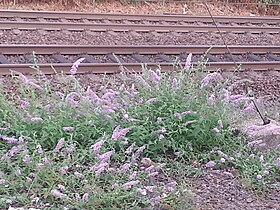
Escaped plant
An escaped plant is a cultivated plant that has escaped from agriculture, forestry or garden cultivation and has become naturalized in the wild. Usually not native to an area, escaped plants may become invasive.[2] Therefore, escaped plants are the subject of research in invasion biology.[3]
Some ornamental plants have characteristics which allow them to escape cultivation and become weedy in alien ecosystems with far-reaching ecological and economic consequences. Escaped garden plants may be called garden escapes[4] or escaped ornamentals.[5] Sometimes, their origins can even be traced back to botanical gardens.
Escaped plants can fall within the definition of, and may have a relation to, these botanical terminologies below:







